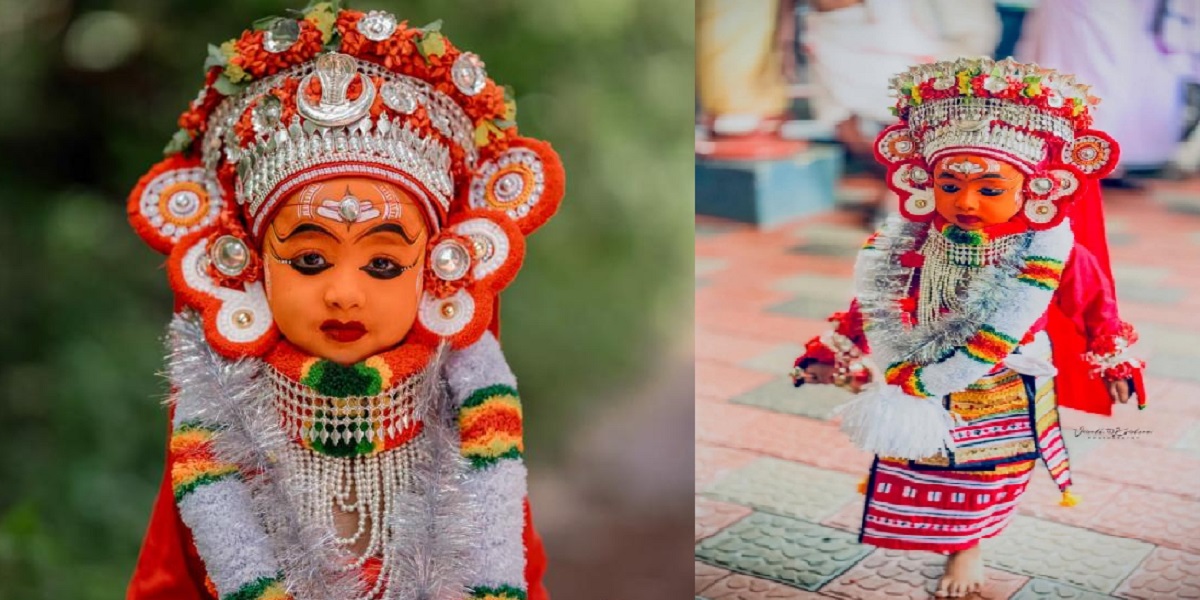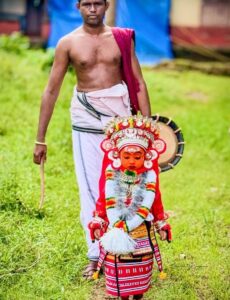Performed during Karkkadakam, the last month in the Malayalam calendar, Vedan Theyyam is believed to bring in prosperity and drive away evil forces.
Published Aug 10, 2025 | 8:00 AM ⚊ Updated Aug 20, 2025 | 9:47 PM

This is the wonder of Aadi Vedan Theyyam in Malabar, where, in the heart of the monsoon, children transform into living deities.
Synopsis: The Malayalam month of Karkkadakam used to be one of famine when the agrarian community had to stay without work as the skies opened up. In the Malabar region, the Vedan Theyyam visited homes to bless the household and to chase away the ills, a practice still followed in North Kerala.
Life takes a slow pace when the monsoon dances down in all its glory in the Malayalam month of Karkkadakam. Those usual early birds prefer to stay in the warmth of their beds for a few minutes more, but often fall into deep slumber, oblivious to the pattering of the rain on rooftops and the vegetation.
Waking up children is a task most mothers will discuss, as the little ones mumble complaints about disturbed sleep before turning around and sneaking under the blanket.
Prayan Prashanth, however, is an exception.
The five-year-old boy wakes up before the sun without complaining to his mother, Anupama. He is eager to visit the homes of his friends and neighbours, not to play, but to bless.
Prayan is no ordinary child. After donning the vibrant costume, the intricate face makeup, and finally the majestic crown—the mudi—he becomes Vedan Theyyam, a manifestation of Lord Shiva.
Once he transforms into Vedan Theyyam, he ceases to be Anupama’s little boy. He becomes a god, a divine presence belonging to the entire village. Moving from house to house, he brings blessings and chases away the season’s ills.
This is the wonder of Aadi Vedan Theyyam in Malabar, where, in the heart of the monsoon, children transform into living deities.
To enjoy the theyyams of Malabar beyond their vibrant colours, striking costumes, and dramatic performances, one must read them through the lens of Hindu mythology. Aadi Vedan Theyyam, also depicted in ancient myth, is one such ritual that comes alive with layers of symbolic meaning.

Prayan, as Vedan Theyyam, on his way to visit homes.
Performed during Karkkadakam, the last month of the Malayalam calendar (July–August), this theyyam is believed to usher in prosperity and drive away evil forces, especially during what is traditionally a difficult time for Malabar’s agrarian communities.
Aadi Vedan Theyyam draws inspiration from the Vana Parva of the Mahabharata. In this tale, Lord Shiva and Parvathy Devi disguise themselves as a tribal couple to test Arjuna’s devotion. When a demon named Mookan, in the form of a wild boar, attacks Arjuna, both he and Shiva shoot it simultaneously, sparking a conflict.
Unable to overpower the mysterious woodsman, Arjuna prays to a clay idol of Shiva and soon realises the divine nature of his opponent. Impressed by Arjuna’s devotion and valour, Shiva blesses him with the powerful Paasupathaasthram. This divine duo—Shiva and Parvathy—takes form in ritual as Vedan and Aadi.
These roles are performed by children aged five to 12. Typically, boys/girls from the Malayan community enact Vedan (Shiva), and the Vannaan community performs Aadi (Parvathy). In Kasaragod, a third character, Galinjan, appears as a representation of Arjuna. The performance can be solo (symbolising Ardhanarishwara) or as a pair, where Vedan enters first, followed by Aadi.
Through the monsoon-drenched courtyards of northern Kerala, these child-performed rituals carry forward ancient stories, offering blessings and preserving tradition.
When South First contacted Prasanth Panicker, a theyyam artist from Kodakkad in Kasaragod and Pravan’s father, he spoke about the deep significance of the art form, both spiritual and practical, for the Malayan community during the monsoon.

Prayan as Vedan Theyyam, performing at a house in his village.
”The theyyam season in Malabar officially begins on the 10th day of the Malayalam month of Thulam, known as Thulam Pathu or Pathamudayam. That’s usually in late October or early November. It lasts for nearly seven months, ending by late May or early June. So during monsoon, when the season pauses, we, the Malayan community, have the right to perform Vedan Theyyam. Beyond tradition and legacy, it’s about survival too,” he said.
”Every theyyam artist in Malabar, including me, usually begins our journey with Aadi or Vedan Theyyam. It’s the first step into ritual performance. Prayan used to watch me perform, and this year, he was excited to do it himself. Even though he’s just five, he quickly picked up the steps and movements of Vedan. As a father, it fills me with pride.” Prasanth said.
Vaisakh Kodakkad, a teacher at KKNM AUPS in Olat, Kasaragod, where Prayan studies, spoke with pride about his student.

Prayan with his classmates.
”Prayan is just in Class 1, and it’s heartwarming to see him perform with such dedication and perfection. There are many children like him in our region who perform Aadi Vedan Theyyam during the monsoon season. One day, Prayan came to school in full costume, and his classmates were thrilled. A video of the moment even went viral on social media.” Vaisakh told South First.
Prasanth chipped in: ”In our childhood, we often skipped school to fully immerse ourselves in theyyam performances. But now, we try not to compromise the children’s education. They’re continuing the tradition without missing too many classes.
Traditionally, Vedan and Aadi Theyyams used to visit schools and Anganwadis, especially since many children aren’t home during the day.
Visiting schools lets us take the theyyam to the children. Some kids get scared and cry, and then teachers help calm them down. But for most, it’s not fear—they see the theyyam as their friend more than a deity.” Prasanth said.
”Nowadays, we cover nearly 100 houses in our village. The performance at each home lasts for about 5 to 10 minutes. If it’s one of Prayan’s friends, he often lingers a little longer, chatting and laughing after the performance. Sometimes, he even tells us to make sure we visit their houses too,” Prasanth smiled.
“For each community, certain areas are allotted. Ours stretches from Vellalan Kotta to Narangathodu. Prayan is accompanied by me and one or two other theyyam artists. The only musical instrument we use during Aadi Vedan Theyyam is the chenda. Face makeup takes about 30 to 45 minutes, and I usually do it for Prayan. He sits quietly, never fidgeting—calm and fully cooperative.”
“Even though he is my son, the moment he wears the ‘mudi, we no longer see a little boy. We see a deity.”
In Aadi Vedan Theyyam, there are no food restrictions, unlike many other forms. After all, it is performed by children. And the character—Lord Shiva in tribal form—is one of simplicity and humility.
Though Prasanth performs powerful and physically demanding forms like Vishnumoorthi, Chamundi, and Pottan Theyyam, survival in the off-season is always uncertain.
”I drive an auto to support my family. I’m the sole breadwinner,” Prasanth said. During Onam and Vishu, artists receive money, rice, and small offerings as dakshina, which helps them get by. ‘The village feeds us. Each theyyam artist survives because the people never forget us.”
Prayan has two twin sisters—Nainika and Naithika—aged two. Sometimes, they’re afraid to approach their brother when he’s in full costume as Vedan. But once the colours wash away and the headgear is off, their beloved brother returns.
And at night, even the miniature god Prayan curls up close to his amma and achan, needing their warmth to fall asleep. Because at the end of the day, he is still just a little boy!
(Edited by Majnu Babu).
